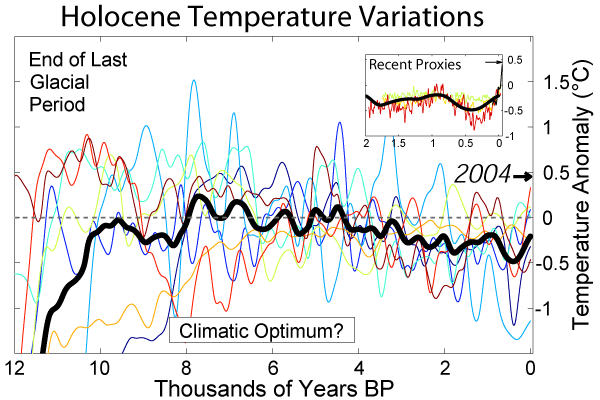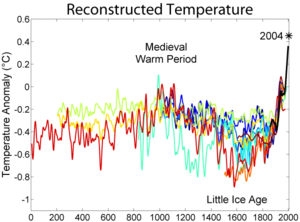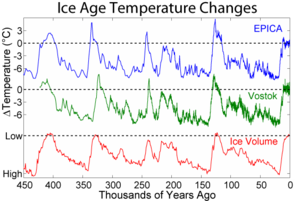File:Holocene Temperature Variations.png
Contents
Summary[edit]
The main figure shows eight records of local temperature variability on multi-centennial scales throughout the course of the Holocene, and an average of these (thick dark line). The data are for the period from 10000 BC to 2000 CE, which is from 12000 BP to the present time. The records are plotted with respect to the mid 20th century average temperature, and the global average temperature in 2004 is indicated. An inset plot compares the most recent two millennia of the average to other recent reconstructions. At the far right of this insert plot, it is possible to observe the emergence of climate from the last glacial period of the current ice age. During the Holocene itself, there is general scientific agreement that temperatures on the average have been quite stable compared to fluctuations during the preceding glacial period. The above average curve supports this belief. However, there is a slightly warmer period in the middle which might be identified with the proposed Holocene climatic optimum. The magnitude and nature of this warm event is disputed, and it may have been largely limited to high northern latitudes.
Because of the limitations of data sampling, each curve in the main plot was smoothed (see methods below) and consequently, this figure can not resolve temperature fluctuations faster than approximately 300 years. Further, while 2004 appears warmer than any other time in the long-term average, and hence might be a sign of global warming, it should also be noted that the 2004 measurement is from a single year (actually the fourth highest on record, see Image:Short Instrumental Temperature Record.png for comparison). It is impossible to know whether similarly large short-term temperature fluctuations may have occurred at other times, but are unresolved by the available resolution. The next 150 years will determine whether the long-term average centered on the present appears anomalous with respect to this plot.
Since there is no scientific consensus on how to reconstruct global temperature variations during the Holocene, the average shown here should be understood as only a rough, quasi-global approximation to the temperature history of the Holocene. In particular, higher resolution data and better spatial coverage could significantly alter the apparent long-term behavior (see below for further caveats). For another estimate of Holocene temperature fluctuations, see: [1]
While any conclusions to be drawn from the long-term average must be considered crude and potentially controversial, one can comment on a number of well established inferences from the individual curves contributing to the average. First, at many locations, there exist large temperature fluctuations on multi-centennial scales. Hence, climate change lasting for centuries appears to be a common feature of many regions. Assuming the timing information from these records is reasonably accurate, it appears that in many cases large changes at any particular site may occur without correlating to similarly large changes at other sites. Secondly, it is also notable that different locations appear to take different amounts of time to reach typical Holocene conditions following the last glacial termination. Scientists generally agree that warming concluded in the far Southern Hemisphere earlier than in most other regions. In part, the prolonged climate change may be related to prolonged changes in sea level, which took till roughly 6000 years ago to reach near modern levels. Some of the differences may also reflect timescale uncertainties.
| Dragons flight's Temperature Record Series |
| This figure is part of a series of plots created by Dragons flight to illustrate changes in Earth's temperature and climate across many different time scales. |
| Time Period: 25 yrs | 150 yrs | 1 kyr | 2 kyr | 12 kyr | 450 kyr | 5 Myr | 65 Myr | 500 Myr |
| For articles related to this topic see: Temperature record |
 |
This graph image could be recreated using vector graphics as an SVG file. This has several advantages; see Commons:Media for cleanup for more information. If an SVG form of this image is available, please upload it and afterwards replace this template with {{vector version available|new image name}}. |
Methods[edit]
To construct this plot, eight data sources (listed below) were selected on the basis of good temporal resolution (preferably ~100 years or less per data point) and coverage of the last 12 kyr. Six of the eight specifically reported temperature and were used as is. The other two reported unscaled temperature proxies and were scaled as described in Notes below. Each curve was smoothed by a Gaussian weighted filter to produce a history of the Holocene temperature variations at that site with approximately 300 year resolution (one exception, see notes). These smooth curves were adjusted to have the same mean over the interval 100-6000 years BP. The average of these curves was then constructed, and the alignment relative to modern day determined by comparing the average over the interval 250-1900 AD relative to the three short-term proxies shown in inset (for details on those plots, see: Image:2000 Year Temperature Comparison.png). Note that the short-term proxies are not at all used in constructing the average itself.
Data Sources[edit]
The following data sources were used in constructing the main plot:
- (dark blue) Sediment core ODP 658, interpreted sea surface temperature, Eastern Tropical Atlantic: M. Zhao, N. A. S. Beveridge, N. J. Shackleton, M. Sarnthein, and G. Eglinton. "Molecular stratigraphy of cores off northwest Africa: Sea surface temperature history over the last 80 ka". Paleoceanography 10 (3): 661-675. doi:10.1029/94PA03354
- (blue) Vostok ice core, interpreted paleotemperature, Central Antarctica: Petit J. R., Jouzel J., Raynaud D., Barkov N. I., Barnola J. M., Basile I., Bender M., Chappellaz J., Davis J., Delaygue G., Delmotte M., Kotlyakov V. M., Legrand M., Lipenkov V., Lorius C., Pépin L., Ritz C., Saltzman E., Stievenard M.. "Climate and Atmospheric History of the Past 420,000 years from the Vostok Ice Core, Antarctica". Nature 399: 429-436. doi:10.1038/20859
- (light blue) GISP2 ice core, interpreted paleotemperature, Greenland: Alley, R. B.. Quaternary Science Reviews. doi:10.1016/S0277-3791(99)00062-1
- (green) Kilimanjaro ice core, δ18O, Eastern Central Africa: Thompson, L. G., E. Mosley-Thompson, M. E. Davis, K. A. Henderson, H. H. Brecher, V. S. Zagorodnov, T. A. Mashiotta, P.-N. Lin, V. N. Mikhalenko, D. R. Hardy, and J. Beer. "Kilimanjaro Ice Core Records: Evidence of Holocene Climate Change in Tropical Africa". Science 298 (5593): 589-593. doi:10.1126/science.1073198
- (yellow) Sediment core PL07-39PC, interpreted sea surface temperature, North Atlantic: Lea, D. W., D. K. Pak, L. C. Peterson, and K. A. Hughen (2003). "Synchroneity of tropical and high-latitude Atlantic temperatures over the last glacial termination". Science 301 (5638): 1361-1364. doi:10.1126/science.1088470
- (orange) Pollen distributions, interpreted temperature, Europe: B. A. S. Davis, S. Brewer, A. C. Stevenson, J. Guiot (2003). Quaternary Science Reviews 22: 1701-1716. doi:10.1016/S0277-3791(03)00173-2
- (red) EPICA ice core, δDeuterium, Central Antarctica: EPICA community members (2004). "Eight glacial cycles from an Antarctic ice core". Nature 429 (6992): 623-628. doi:10.1038/nature02599
- (dark red) Composite sediment cores, interpreted sea surface temperature, Western Tropical Pacific: L. D. Stott, K. G. Cannariato, R. Thunell, G. H. Haug, A. Koutavas, and S. Lund (2004). "Decline of surface temperature and salinity in the western tropical Pacific Ocean in the Holocene epoch". Nature 431: 56-59. doi:10.1038/nature02903
Additional data used in inset plot and for matching temperature scale to modern values. Colors match those used in Image:2000 Year Temperature Comparison.png.
- (orange 200-1995): P. D. Jones and M. E. Mann (2004). "Climate Over Past Millennia". Reviews of Geophysics 42. doi:10.1029/2003RG000143
- (red-orange 1500-1980): S. Huang (2004). "Merging Information from Different Resources for New Insights into Climate Change in the Past and Future". Geophys. Res Lett. 31: L13205. doi:10.1029/2004GL019781
- (red 1-1979): A. Moberg, D. M. Sonechkin, K. Holmgren, N. M. Datsenko and W. Karlén (2005). "Highly variable Northern Hemisphere temperatures reconstructed from low- and high-resolution proxy data". Nature 443: 613-617. doi:10.1038/nature03265
- (thin black line 1856-2004): Instrumental global annual data set TaveGL2v [2]: P. D. Jones and A. Moberg (2003). "Hemispheric and large-scale surface air temperature variations: An extensive revision and an update to 2001". Journal of Climate 16: 206-223.
Copyright[edit]
This figure was prepared by Robert A. Rohde from publicly available data and is incoporated into the Global Warming Art project. Most, but not all, of the original data is available from [3].
 |
Permission is granted to copy, distribute and/or modify this document under the terms of the GNU Free Documentation License, Version 1.2 or any later version published by the Free Software Foundation; with no Invariant Sections, no Front-Cover Texts, and no Back-Cover Texts. A copy of the license is included in the section entitled GNU Free Documentation License. |
| This file is licensed under the Creative Commons Attribution-Share Alike 3.0 Unported license. | ||
|
||
| This licensing tag was added to this file as part of the GFDL licensing update. |
Caveats[edit]
- A typical modern temperature construction involves tens or hundreds of records to ensure reasonable global coverage. Because the average shown here involves only 8 records, it is entirely plausible that significant contributions to temperature variation are being overlooked because certain large regions (e.g. Asia) are not being sampled.
- Different regions have different sensitivity to global temperature variations, so one can reasonably argue that a true global average reconstruction requires scaling the different records to match local sensitivity. Since no scientific consensus exists for how to do this, no attempt was made to do this.
- Given the limited spatial sampling, it is unclear whether the slightly warmer period during the Holocene climatic optimum corresponds to a statistically significant difference.
- Because the Davis et al. pollen reconstruction is based on measurements across many sites in Europe, it is more reasonably described as a regional rather than a local temperature measurement. Similarly, it shows considerably less short-term variability than most other sites.
- A small number of records, not used in this study, have been interpreted as indicating much larger temperature variation during the Holocene (5+ °C) than the records represented here. In many cases, critics have interpreted these changes to reflect seasonal, rather than annual variations in temperature, or very unusual local changes. However, the possibility exists that the current reconstruction underestimates long-term variability.
- During the earliest parts of this record, the timing uncertainty on some records may become substantial, potentially exceeding a couple hundred years. This could have the result of causing correlated features to fall out of alignment.
- And the most important caveat: Though all of this data is published, and the methodology is similar to previously published methodology, and resulting average is similar to previously published interpretations of the Holocene, even so, no peer reviewed scientific publication has ever combined precisely these data in precisely this way. Hence, any interpretation of that average must be regarded with skepticism.
Notes[edit]
- The time scale for the EPICA ice core was adjusted to the EDC1 (Schwander et al. 2001), which is the preferred time scale for the last 80 kyr.
- The time scale for sediment core ODP 658 was converted from the listed Carbon-14 time scale to calendar years by using the marine INTCAL04 calibration curve (Hughen et al. 2004).
- Because of poorer data resolution, the sediment core PL07-39PC was smoothed to an approximately 500 year average.
- δDeuterium record of the EPICA ice core was converted to temperature variation by using the δDeuterium to temperature proportionality determined for the Vostok ice core.
- δ18O temperature proxy from the Kilimanjaro ice core was converted to °C by scaling its variance from the interval 100-6000 years BP to match that reported in the Vostok ice core during the same period.
Additional References[edit]
- J. Schwander, J. Jouzel, C.U. Hammer, J.-R. Petit, R. Udisti, and E.W. Wolff (2001). "A tentative chronology for the EPICA Dome Concordia ice core". Geophysical Research Letters 28 (22): 4243-4246.
- KA Hughen, MGL Baillie, E Bard, A Bayliss, JW Beck, C Bertrand, PG Blackwell, CE Buck, G Burr, KB Cutler, PE Damon, RL Edwards, RG Fairbanks, M Friedrich, TP Guilderson, B Kromer, FG McCormac, S Manning, C Bronk Ramsey, PJ Reimer, RW Reimer, S Remmele, JR Southon, M Stuiver, S Talamo, FW Taylor, J van der Plicht, and CE Weyhenmeyer (2004). "Marine04 Marine Radiocarbon Age Calibration, 0–26 Cal Kyr BP". Radiocarbon 46: 1059-1086.
derivative works[edit]
Derivative works of this file: Variacions de temperatura a l'Holocè.png
File history
Click on a date/time to view the file as it appeared at that time.
| Date/Time | Thumbnail | Dimensions | User | Comment | |
|---|---|---|---|---|---|
| current | 23:50, 19 July 2010 |  | 600 × 400 (38 KB) | SeL media (talk | contribs) | time axis reversed |
| 22:39, 4 July 2009 |  | 600 × 400 (35 KB) | Falcorian (talk | contribs) | Lossless compression with pngout. | |
| 22:51, 17 December 2005 |  | 600 × 400 (43 KB) | Saperaud~commonswiki (talk | contribs) |
- You cannot overwrite this file.
File usage on Commons
The following 10 pages link to this file:
- Top 200 graph images that should use vector graphics
- User:Tryphon/Top 200 graph images that should use vector graphics
- File:2000 Year Temperature Comparison.png
- File:2000 Year Temperature Comparison cs.png
- File:Ice Age Temperature.png
- File:Rekonstrukcja Temperatury.PNG
- File:Rekonstrukcja Temperatury2.PNG
- File:Rekonstrukcja temperatury.png
- File:Vostok-ice-core-petit.png
- Category:User:Dragons flight
File usage on other wikis
The following other wikis use this file:
- Usage on ar.wikipedia.org
- Usage on az.wikipedia.org
- Usage on ca.wikipedia.org
- Usage on cs.wikipedia.org
- Usage on de.wikipedia.org
- Usage on el.wikipedia.org
- Usage on en.wikipedia.org
- Global warming controversy
- Holocene
- Paleoclimatology
- Temperature record
- Holocene climatic optimum
- User:Dragons flight/Images
- Holocene glacial retreat
- Atlantic (period)
- Talk:Global warming/Archive 26
- User:Mporter/Climate data
- User:Debnigo
- Piora Oscillation
- Bond event
- Wikipedia:Reference desk/Archives/Science/2007 September 26
- Subboreal
- Talk:Global warming/Archive 60
- Climate oscillation
- Talk:Global warming/Archive 71
- Usage on es.wikipedia.org
- Holoceno
- Mammuthus
- Discusión:Calentamiento global/Archivo 1
- Oscilación de Piora
- Anexo:Científicos escépticos sobre las aseveraciones del calentamiento global
- Máximo del Holoceno
- Registro de temperaturas
- Ciclos climáticos de 1500 años
- Discusión:Calentamiento global/Archivo 2008 y anteriores
- Usuario:Ángel Luis Alfaro/artículos/Tiempo
- Anexo:Línea de tiempo de la historia medioambiental
- Usage on et.wikipedia.org
- Usage on fa.wikipedia.org
- Usage on fi.wikipedia.org
- Usage on fr.wikipedia.org
- Usage on gl.wikipedia.org
- Usage on hu.wikipedia.org
- Usage on it.wikipedia.org
View more global usage of this file.


